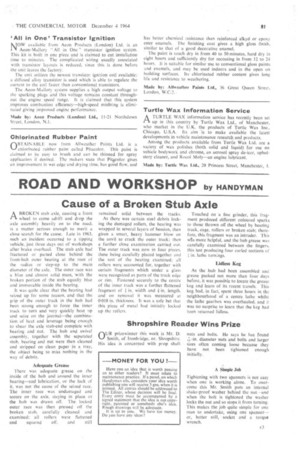ROAD AND WORKSHOP by HANDYMAN
Page 83

If you've noticed an error in this article please click here to report it so we can fix it.
Cause of a Broken Stub Axle
ABROKEN stub axle, causing a front wheel to come adrift and drop the axle assembly heavily on to the road, is a matter serious enough to merit a close search for the cause. Late in 1963, such an incident occurred to a tipping vehicle, just three days out of workshops after brake overhaul. The stub axle had fractured or parted close behind the front-hub outer bearing at the root of the radius or step-up to the main diameter of the axle. The outer race was a blue and almost solid mass, with the broken portion of the stub equally blue and immovable inside the bearing.
it was quite clear that the bearing had seized up for some reason, and that the grip of the outer track in the hub had been strong enough to force the inner track to turn and very quickly heat up and seize on the journal—the combination of heat and leverage being enough to shear the axle stub-end complete with bearing and nut. The hub and swivel assembly, together with the separated stub. bearing and nut were then cleaned and stripped on clean paper in a tray, the object being to miss nothing in the way of debris.
Adequate Grease There was adequate grease on the inside of the hub and around the inner bearing—and lubrication, or the lack of it, was not the cause of the seized race. The inner race was undamaged and secure on the axle, staying in place as the hub was drawn off. The locked outer race was then pressed off the broken stub, carefully cleaned and examined; all rollers were flattened and squared off, and still remained solid between the tracks.
As there was certain steel debris locking the damaged rollers, the bearing was wrapped in several layers of hessian, then given a smart, heavy hammer blow on the anvil to crack the outer track; then a further close examination carried out. The outer track was now in four pieces. these being carefully placed together and the rest of the bearing examined; all rollers were accounted for, together with certain fragments which under a glass were recognized as parts of the track edge or rim. Fastened securely to the centre of the inner track was a further flattened fragment of in, width and I in, length, and on removal it was measured at 0.018 in. thickness. It was a safe bet thai this piece of metal had initially locked up the rollers.
Touched on 'a fine grinder, this fragment produced different coloured sparks to those thrown off the wheel by bearing track, cage, rollers or broken stub; therefore, this fragment was an intruder. This Wffs more helpful, and the hub grease was carefully examined between the fingers, this test producing four curled sections of t in. lathe turnings.
Lidless Keg As the hub had been assembled and grease packed not more than four days before, it was possible to locate the grease keg and learn of its recent travels. This keg had, in fact, spent three hours in. the neighbourhood of a centre lathe whilst the lathe gearbox was overhauled, and it was no surprise to learn that the keg had been returned lidless.
































































































































































































